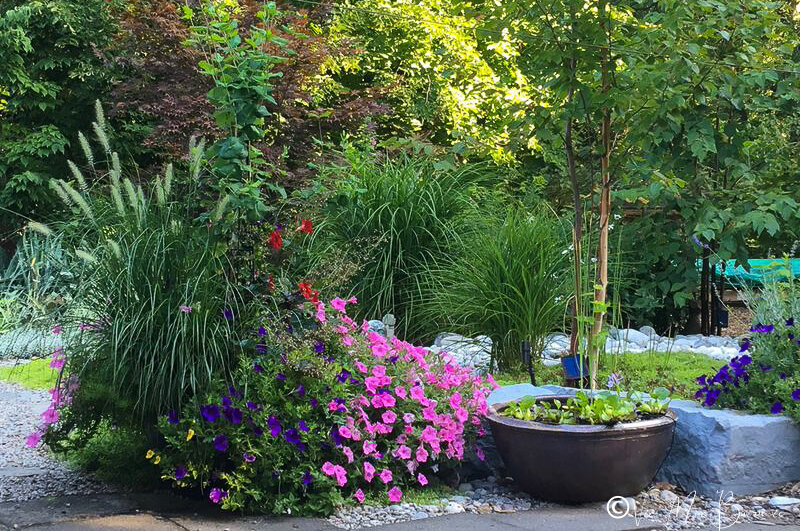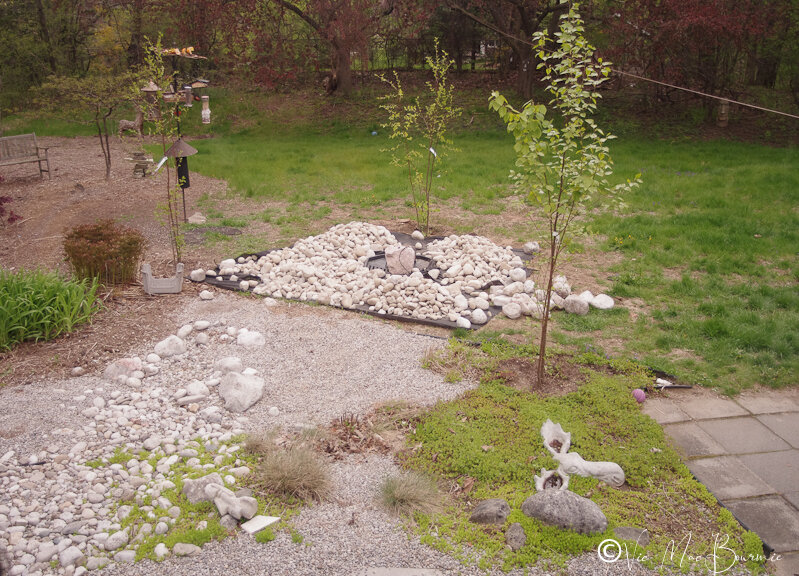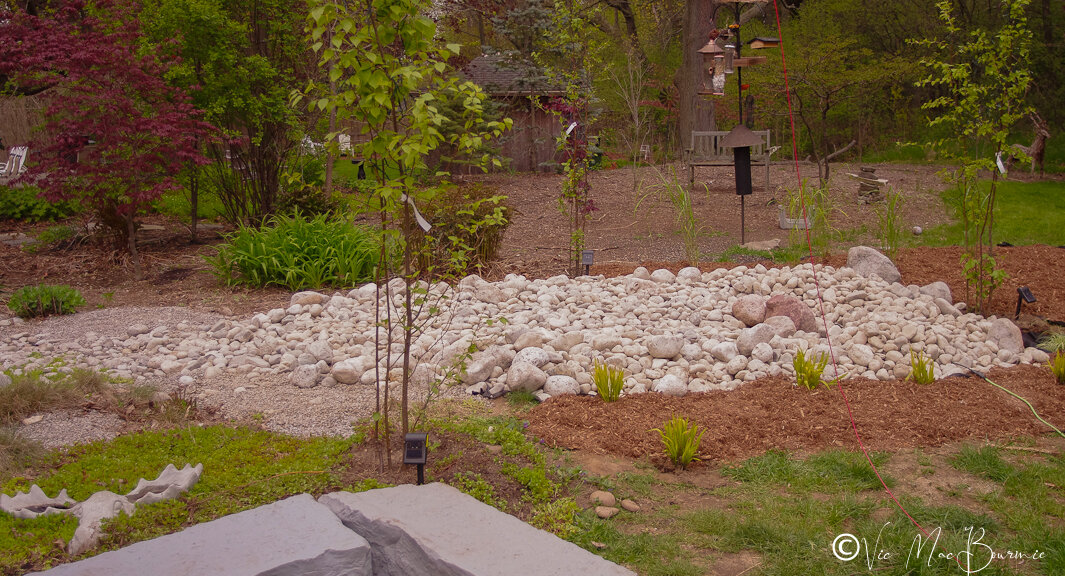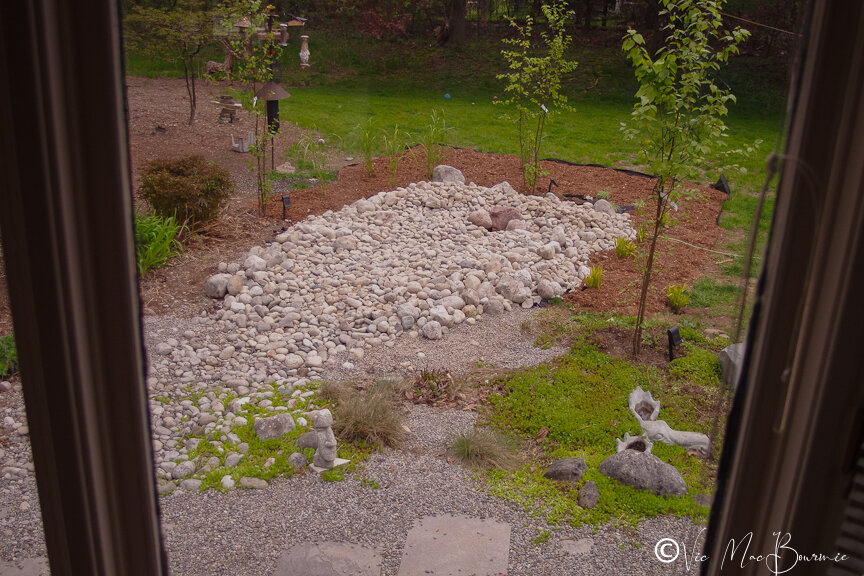Birch Grove comes to life in Woodland garden
Will a Birch grove attract wildlife in the garden
Why plant a single birch tree when you can plant ten or eleven and create a birch grove?
Technically, our birch grove is not ten separate trees but there are at least ten trunks rising up out of the ground to form the stand or birch grove.
When the birch clumps were first planted about five years ago, the trees were small and offered little support to one another or to local wildlife, but it wasn’t long before these fast-growing trees put on enough growth that their branches began to weave into one another and form an overhead canopy that through a light shade on the ground below including the water from the bubbling rock. I imagine what is going on above ground is also happening underground with the trees’ roots beginning to intermingle and work together to create a highly supportive environment that best supports their needs.
Now that the canopy is forming and the branch tips are beginning to touch one another about six feet up from the ground, it’s not hard to see the affect the grove is having on the trees and the area around them.
Birds are arriving to look for food and check out the trees as a potential nesting site. It’s probably too early for nesting, but the grove certainly offers many of the requirements birds need to set up a successful family, including hosting a number of caterpillars and other insects as well as providing seeds in the fall in the form of catkins.
Beneath the canopy, a small, solar-powered bubbling rock provides a host of birds and small mammals with moving water for both drinking and bathing. The canopy helps to shade the bubbling rock and below-ground water reservoir providing cooler water for birds, mammals and even insects to enjoy three seasons of the year.
More great ideas for under your Birch Grove
Maybe a dry river bed and bubbling rock is of little interest to you. Here are a few other ideas you could create under the canopy of your Birch Grove.
A beautiful bed of moss with a lovely natural bird bath made from granite or copper.
A quiet sitting area complete with a comfortable rustic chair or natural bench. A large single flat-topped boulder would be the perfect addition.
A quiet place with a lovely bird feeder and sitting area to escape to with the birds
A small pond and sitting area where you can relax with a good book
For more stories on the value of birch trees in our woodlands, check out the following stories.
• How long before my birch tree trunks turn white?
• Why are my birch tree leaves turning yellow prematurely?
• In the video that accompanies this article you will notice two schools of ceramic fish. Click on this link for my article on Fish In The Garden.
Why not use a single birch tree?
Would a single large birch tree be good enough?
As Peter Wohllenben explains in his New York Times best seller, The Hidden world of Trees: What They Feel, How they Communicate, a single tree is on its own, braving high winds, blistering heat and full sun. It’s like a “street kid” trying to survive in an extremely difficult world without the help of parents, friends and relatives.
Life is difficult and often short for these trees.
On the other hand, The three clump birches surrounding our bubbling rock and dry-river-bed work together to create their own environment both above and below ground.
They cast shade on one another and help to cool the soil around all of the trees while preserving vital moisture the birches need to thrive in the hot summer months.
The groupings of trees also work together to slow strong, gusting winds from damaging the trees, which can be devastating for birch trees that are particularly susceptible to disease and insect infestation.
The Hidden World of Trees is clear about the benefits of multiple trees working together as a team rather than as singular specimens. In a mature forest, for example, much of the benefit is provided by the “mother tree” that helps nearby related trees through its massive root system.
In his book, Wohlleben writes: “A tree is not a forest. On its own, a tree cannot establish a consistent local climate. It is at the mercy of wind and weather. But together, many trees create an ecosystem that moderates extremes of heat and cold, stores a great deal of water, and generates a great deal of humidity. And in this protected environment, trees can live to be very old. To get to this point, the community must remain intact no matter what. If every tree was looking out for only itself, then quite of few of them would never reach old age.”
How quickly do Birch trees grow?
Birch trees are considered relatively fast growers where they are happy. On a good year, expect anywhere from 13 inches to more than 24 inches (or two feet) a year for your average White Birch tree or clump. River birches have a similar growth habit but can be a much longer-lived tree due to its better resistance to birch tree borers. The paper birch grows to a height of between 50’-70’ with a spread of around 35’ when mature.
Up lighting adds an elegant touch to the look of birch tree clumps in the evening.
Can other trees be planted in groves?
Besides the benefits the actual trees derive from planting groves over a single tree, there is also the aesthetic value that should not be overlooked. Let’s face it, several groupings of the same tree not only looks natural in a woodland setting, it’s can be very impressive in the landscape.
And you don’t have to be limited to a birch grove.
Any time you are planning to create a new garden area, consider planting multiples of the same tree to create similar effects as the birch grove.
Other plantings that would work are a grouping of multi-stemmed serviceberries or pagoda dogwoods. Imagine a grouping of Flowering dogwoods in an area of the garden. These trees are all available in multi-stem forms and grow much smaller than birch trees.
The results would be stunning, small stands that would be invaluable to local wildlife both in spring when they flower and, more importantly, in late summer and fall when the berries create a smorgasbord for native wildlife from birds to mammals.
I remember a professional landscape design plan for a small side yard where the owners required a shaded area that provided quick privacy from neighbours. The design plan called for three, fast growing native single-stem Tulip trees in a relatively confined space. The result, a fast-growing tulip tree stand that, in just a few short years, created a shaded side yard that grew fast enough to provide quick privacy for the family.
The landscaper was quick to point out that the high growth rate of these trees would require regular pruning to keep them under control.
With more time, three single-stem serviceberry trees would create a similar effect, albeit on a smaller scale.
Large plantings make a strong garden statement
But back to our birch grove and why I love it.
The simple answer is that mass plantings look great and create a strong statement in the landscape.
Planting three large clumps to create a grove or stand, makes it clear to visitors that this is an important focal point in the garden.
The beginnings of our Birch Grove
Our birch grove began with a large swath of dead grass. (see images below)
The dying grass, undoubtedly caused by our dog urinating in the area all winter, only provided an opportunity to create something new and more useful than a patch of grass.
Nature’s own grove of trees stand out among maples in the fall on the edge of a natural woodland.
How to plant a birch grove
Planting the birch grove was part of a much larger project – the creation of a bubbling rock at the head of a dry river bed that flows a into a walkway of pea gravel combined with river rock and slate stepping stones.
The design concept was to bring it all together as one large dry-river walkway.
The concept behind the birch grove was to help tie it together vertically and soften the landscape design.
Three large planting holes were dug about 10-feet apart in a triangular form and backfilled with a moderate amount of high quality soil. (I tend not to change the soil makeup in the planting hole too much, preferring to allow the tree roots to grow primarily in the soil they will eventually live in for the majority of their lives.)
Unless you have clay soil, plant the clump so that the top of the root ball is level with the soil. Planting it higher will limit its ability to get water. If you have clay soil, consider digging out larger planting holes, adding gravel to the bottom of the hole and planting the top of the root ball a few inches higher to ensure the trees don’t drown from sitting in a bowl of water.
Birch trees require moist soil so mulching around the tree roots is vital.
In our case, the mulch ranges from organic mulch such as shredded bark applied directly around the newly-planted clumps, to living mulch (plants), and non-organic mulch made up primarily of different sized river rock.
The roots of all three clumps will eventually grow beneath the dry-river bed, and the light-coloured stones will reflect any harsh sunlight which will help to keep the tree roots cool.
In other areas surrounding the stand of birches, a thick layer of sedum and ornamental grasses provide an organic mulch that, while robbing the trees of some water, also help to shade the area.
Below is a series of pictures showing the construction of the Birch grove along with the dry river bed and small solar bubbling rock.




What are the best type of Birch trees to create a grove
There are several types of birch trees to consider if you are planning to create a birch grove, including Yellow Birch (Betula alleghaniensis), Sweet Birch (Betula lenta), River Birch (Betula nigra), Paper Birch (Betula papyrifera), Gray Birch (Betual populifolia)
Are some better than others? Absolutely, but it depends on the look you are after.
Birch trees grow in hardiness zones 2 through 7.
For outstanding beauty, the pure white bark of the Paper Birch is likely the best choice. It grows to about 18 meters or 60 ft. with a spread of 11 m or 35 ft. It can live to about 70 years but rarely gets to this age in an urban or even semi-urban environment.
White birches adapt to most types of soil as long as it is cool in summer preferring long winters and mild summers. They are also susceptible to a number of insects, including the highly destructive bronze birch borers. Regular fertilizing and mulching the tree roots helps the tree resist borers.
Cultivars are also available that are created to better resist borers.
Don’t underestimate, however, the more subtle beauty of the River Birch with its extensive amounts of exfoliating cinnamon-coloured bark with pink undertones. The River Birch is more borer resistant than white bark birches, which makes it a much longer-lived landscape tree.
River Birches grow to about the same height and width as White Birch, also likes full sun and is considered a fast grower.
In another area of our garden, I have used three weeping silver birches (Betula pendula) to create a small grove. The weeping birches are European species that require many of the same conditions as the native trees – primarily mild summer and cold winters together with moist soil and a sunny area.
What birds and other wildlife are attracted to birch trees?
Birds are attracted to all forms of Birch trees for the food they provide in the form of seeds (found in cone-shaped strobili), buds. Birds are especially attracted to Birch trees in spring for the wealth of insects (primarily caterpillars). Birch trees also have high sap content, which makes them a favorite of the Yellow-Bellied Sapsucker. Other birds that use Birch Trees as a food source include American Goldfinch, Black-Capped Chickadee, Blue Jays, Dark-Eyed Junco, Eastern Towhee, insect-eating Warblers, Northern Cardinals, Pine Siskin, Purple Finch, Tufted Titmouse and Nuthatches.



